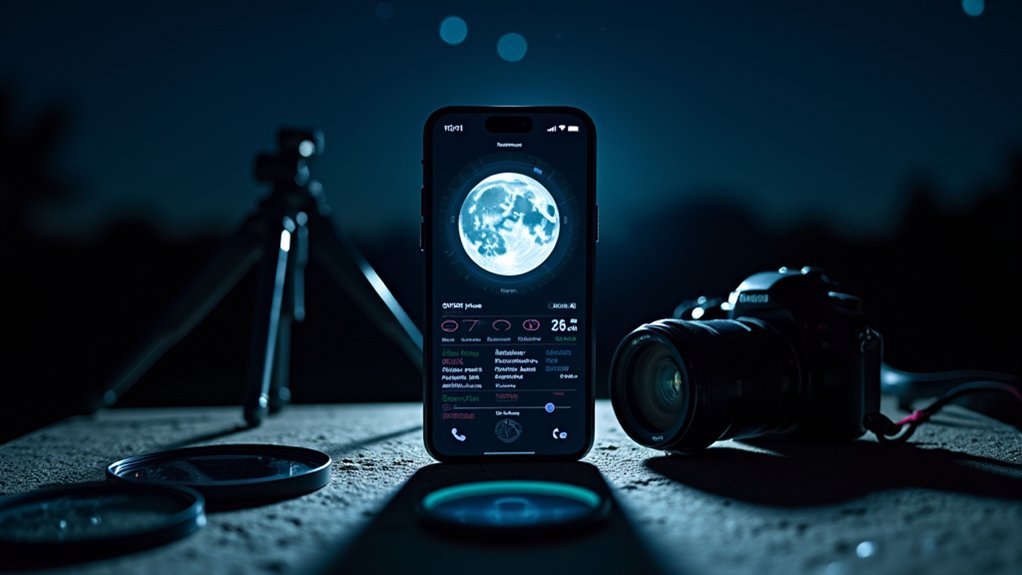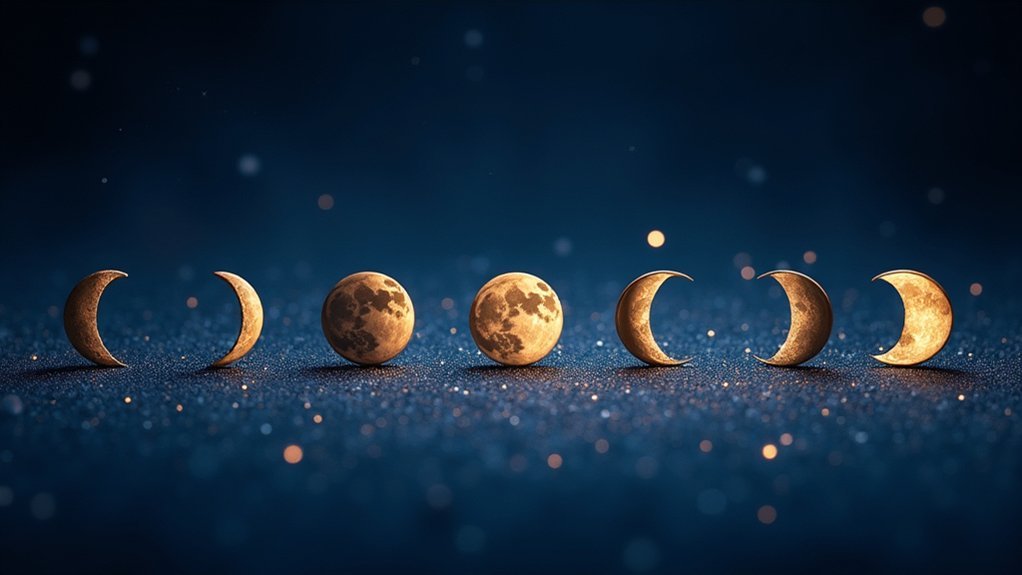Capture stunning starscapes by leveraging these seven essential moon phase tools: moon phase apps, lunar calendars, clear sky charts, specialized weather radars, light pollution maps, moon position calculators, and affordable tracking equipment. You’ll predict ideal shooting conditions, find perfect locations away from light pollution, and plan compositions with dramatic moon alignments—all without breaking the bank. From timing your shoots during new moons to positioning the crescent moon behind landscape elements, these tools transform ordinary night photos into breathtaking cosmic masterpieces.
Moon Phase Apps: Essential Tracking for Night Sky Photographers

When capturing the perfect starscape, timing is everything. Moon phase apps provide critical tools that help you plan shoots around ideal lunar conditions, ensuring stellar visibility and image quality.
Precise lunar timing transforms ordinary night photography into breathtaking celestial masterpieces.
These apps track moon phases with precision, alerting you to upcoming celestial events like full moons and eclipses. The interactive sky maps and charts featured in most apps allow you to visualize moonrise and moonset times relative to other celestial bodies.
This helps you determine exactly when the moon will enhance—rather than overpower—your composition. Many apps also integrate with additional astronomical tools, providing real-time data on light conditions and star visibility.
Whether you’re a beginner or seasoned professional, the user-friendly interfaces make selecting the best shooting times effortless and intuitive.
Clear Sky Charts: Predicting Optimal Imaging Conditions
Clear Sky Charts offer you essential weather prediction data specifically designed for astronomical imaging, with color-coded forecasts showing cloud cover, transparency, and seeing conditions over a 48-hour period.
You’ll find these charts update every six hours, allowing you to plan your stargazing sessions with current information about visibility factors in your location.
Weather Prediction Essentials
Successful lunar photography hinges on your ability to anticipate ideal viewing conditions. Clear Sky Charts provide the detailed forecasts you’ll need, with color-coded maps showing cloud cover, transparency, and seeing conditions. Blue areas indicate prime visibility while red warns of poor conditions.
| Forecast Element | What to Look For | Impact on Imaging |
|---|---|---|
| Cloud Cover | Deep blue indicators | Clear shots without obstruction |
| Transparency | Dark blue sections | Better moon phase visibility |
| Seeing | Blue regions | Sharp lunar detail capture |
| Light Pollution | Darker areas | Enhanced contrast in starscapes |
| Moon Position | Rise/set timing | best positioning in frame |
These charts update regularly, ensuring you’re working with current data. Check forecasts for your specific location to maximize your chances of capturing stunning lunar imagery under best atmospheric conditions.
Visibility Factor Analysis
Beyond basic weather forecasts lies a more sophisticated tool specifically designed for stargazers. Clear Sky Charts provide extensive visibility forecasts tailored for astrophotography, helping you pinpoint best imaging conditions with remarkable precision.
These color-coded maps reveal essential factors that determine your starscape quality:
- Cloud cover predictions that let you avoid wasted trips when skies won’t cooperate.
- Transparency forecasts showing when atmospheric conditions will yield the crispest star details.
- Seeing conditions that indicate atmospheric stability for sharper lunar features.
- Moon phase visibility information to plan shoots around ideal lunar lighting.
Weather Radars Specialized for Stargazing Sessions

While traditional weather forecasts serve everyday needs, specialized weather radar tools have revolutionized how astronomers plan their observations under the night sky.
You’ll find these tools integrate seamlessly with stargazing apps, providing real-time updates on cloud cover and atmospheric conditions that might interfere with viewing different phases of the moon.
These advanced radar systems do more than track precipitation—they utilize satellite imagery to predict clear skies, allowing you to schedule your sessions during ideal viewing windows.
When planning Moon observations, you’ll appreciate details on humidity levels and wind speeds that affect atmospheric stability.
Many platforms also offer interactive maps highlighting areas with minimal light pollution alongside favorable weather conditions, ensuring you don’t waste time setting up equipment during unfavorable conditions.
Lunar Calendars and Their Role in Composition Planning
Moving from weather prediction to planning your actual lunar photography, lunar calendars serve as the backbone of any well-executed starscape composition.
They reveal essential information about moon phases, allowing you to align your shoots with ideal lighting conditions.
By consulting lunar calendars, you’ll gain:
- Freedom to capture the Milky Way during new moon phases when skies are darkest and stars shine brightest
- Perfect timing for moonrise/moonset to incorporate dramatic lunar silhouettes against starry backdrops
- Advance notice of spectacular events like eclipses that transform ordinary night skies into once-in-a-lifetime shots
- Insight into lunar libration patterns that help you showcase specific crater details alongside celestial objects
These tools empower you to move beyond random night photography to intentional starscape artistry by understanding exactly how the moon will influence each composition.
Light Pollution Maps for Choosing the Perfect Location

Where you shoot matters just as much as when you shoot in starscape photography.
Light pollution maps are invaluable tools that help you identify locations with minimal artificial light interference, maximizing your chances of capturing breathtaking night sky images.
These color-coded maps indicate light pollution levels, with darker shades representing ideal stargazing conditions. You’ll find numerous online resources and astronomy apps offering these maps to plan your shoots effectively.
By selecting locations away from urban light sources, you’ll dramatically enhance the visibility of celestial objects in your photographs.
Before your next astrophotography session, consult a light pollution map to find pristine dark skies.
This simple step can transform your starscapes from washed-out disappointments to crystal-clear celestial masterpieces with vivid stars and detailed cosmic features.
Moon Position Calculators for Creative Foreground Elements
Moon position calculators offer powerful foreground alignment tools that let you perfectly frame the moon with landscape features for dramatic compositions.
Many apps include silhouette prediction features, showing you exactly how mountains, buildings, or trees will appear against the night sky when the moon rises or sets.
These tools’ location scouting capabilities help you identify ideal vantage points where the moon will align with interesting terrain features, saving you countless hours of trial and error in the field.
Foreground Alignment Tools
Three essential tools have revolutionized how photographers align the moon with foreground elements in starscape photography.
These specialized calculators help you predict precise moon phases and positions, enabling creative compositions that merge celestial beauty with landscape features.
Using these foreground alignment tools, you’ll experience:
- The thrill of capturing perfectly timed shots where the moon aligns exactly with architectural elements.
- The satisfaction of planning weeks ahead to position the moon precisely behind mountains or trees.
- The confidence of knowing exact moonrise and moonset times for your shooting location.
- The creative freedom to experiment with different elevations and azimuth angles for unique perspectives.
Landscape Silhouette Predictions
Taking foreground alignment a step further, landscape silhouette predictions allow you to craft truly stunning compositions with precise lunar positioning.
Moon position calculators provide exact timing for when the Moon will align with your chosen landscape silhouette, creating dramatic visual impact in your starscapes.
These powerful tools integrate with GPS to customize predictions for your exact shooting location.
You’ll know precisely when different moon phases will position the lunar disk behind mountain ridges, trees, or architectural elements.
Instead of hoping for lucky alignments, you can plan your shoots with confidence.
Location Scouting Features
When planning a breathtaking starscape composition, location scouting features in moon position calculators become your most valuable asset.
Tools like PhotoPills and Stellarium help you visualize exactly where the moon will appear in relation to your chosen landscape elements.
Effective location scouting using these moon phases tools allows you to:
- Identify perfect foreground elements that create depth against the celestial backdrop
- Find shooting locations with minimal light pollution for clearer star visibility
- Predict exactly when the moon will align with specific landscape features
- Determine ideal shooting angles that balance moonlight with starlight visibility
Affordable Lunar Tracking Equipment for Budget Astrophotographers
Capturing the moon’s mystique doesn’t require emptying your wallet on expensive gear. Affordable tracking mounts like the iOptron SkyTracker and Celestron StarSense allow you to track moon phases with impressive precision, enabling those extended exposures that reveal lunar details.
| Equipment Type | Budget Options | Price Range | Key Benefit |
|---|---|---|---|
| Tracking Mount | iOptron SkyTracker | $200-300 | Stable long exposures |
| Tripod | Manfrotto Compact Action | $50-100 | Essential stability |
| Phone Adapter | Universal Smartphone Mount | $15-30 | Use existing camera |
| Wide-Angle Lens | Rokinon 14mm F2.8 | $250-350 | Capture expansive scenes |
Complement your setup with free software like LunarPhase Pro to plan your shoots strategically. By attaching your smartphone to binoculars using an inexpensive adapter, you’ll capture impressive lunar images without spending a fortune.
Frequently Asked Questions
What Moon Phase Is Best for Stargazing?
You’ll get the best stargazing during a new moon when skies are darkest. Crescent moons also work well, while first quarter moons offer decent conditions. Avoid full moons as they’ll wash out faint celestial objects.
What Is the Best Moon Phase for Star Trails?
For star trails, you’ll want to shoot during the new moon phase when there’s no moonlight to interfere. This darkness maximizes star visibility, creating more dramatic and well-defined trails in your long-exposure photographs.
What Is the Best Moon Phase for Decluttering?
The best moon phase for decluttering is the new moon. You’ll benefit from darker skies with minimal moonlight distractions. Crescent moons and last quarter phases also work well if you’re organizing your stargazing space.
Do Moon Phase Watches Actually Work?
Yes, moon phase watches do work! They accurately track the 29.5-day lunar cycle through mechanical or quartz movements. You’ll find they’re reliable tools, though they may need occasional adjustment to maintain perfect synchronization with actual lunar phases.
In Summary
You’ve now explored seven essential tools that’ll transform your night photography game. Whether you’re tracking the moon’s journey, predicting clear skies, or finding dark locations, these resources work together to elevate your starscapes. Remember, understanding the moon’s phase and position isn’t just technical—it’s artistic. With these accessible tools at your fingertips, you’ll capture breathtaking celestial compositions that once seemed beyond reach.





Leave a Reply